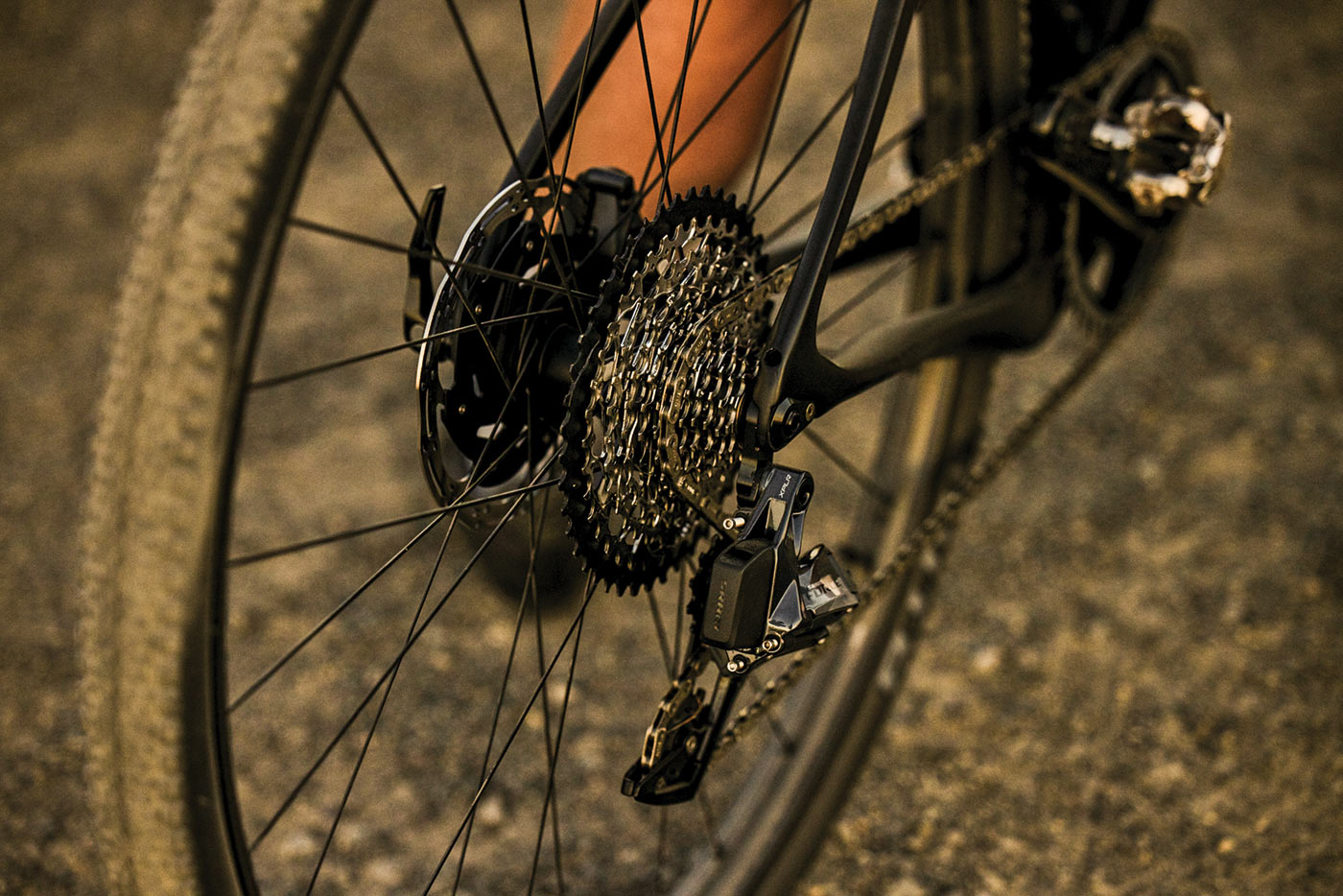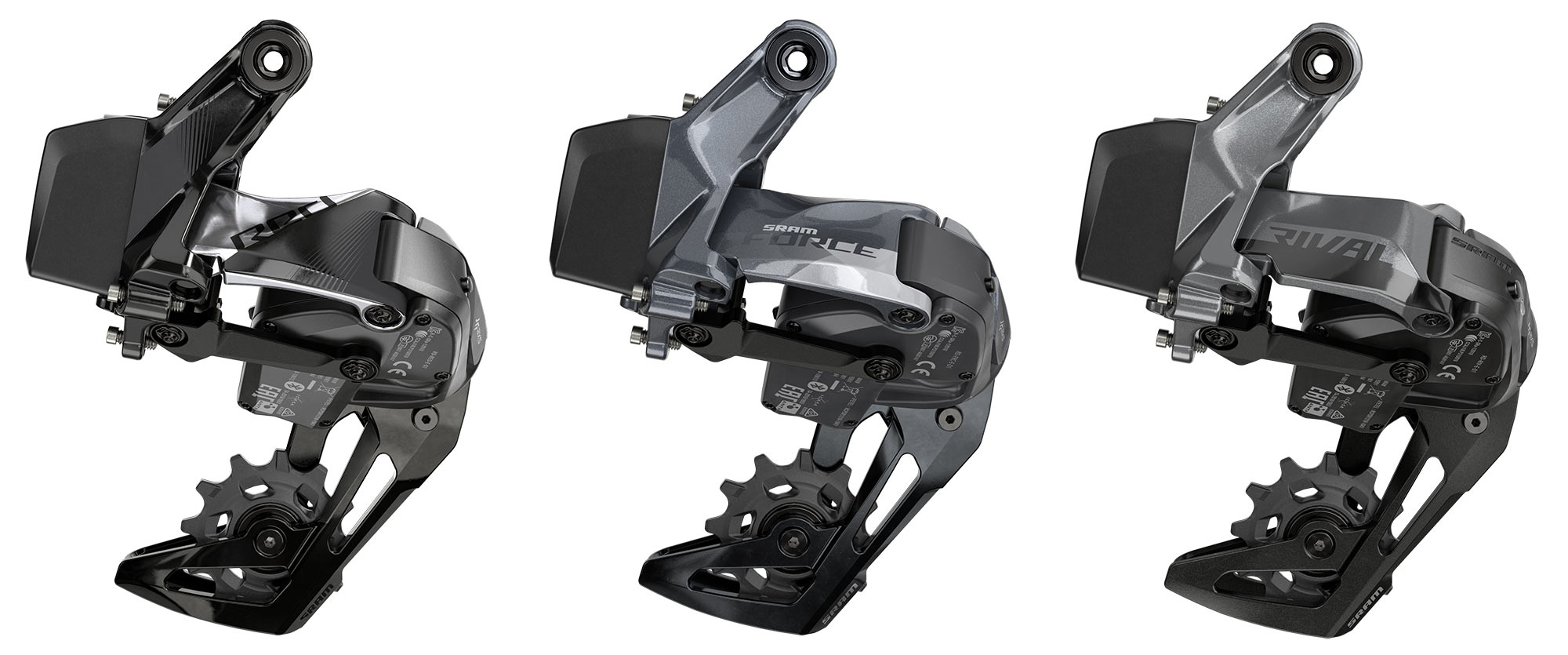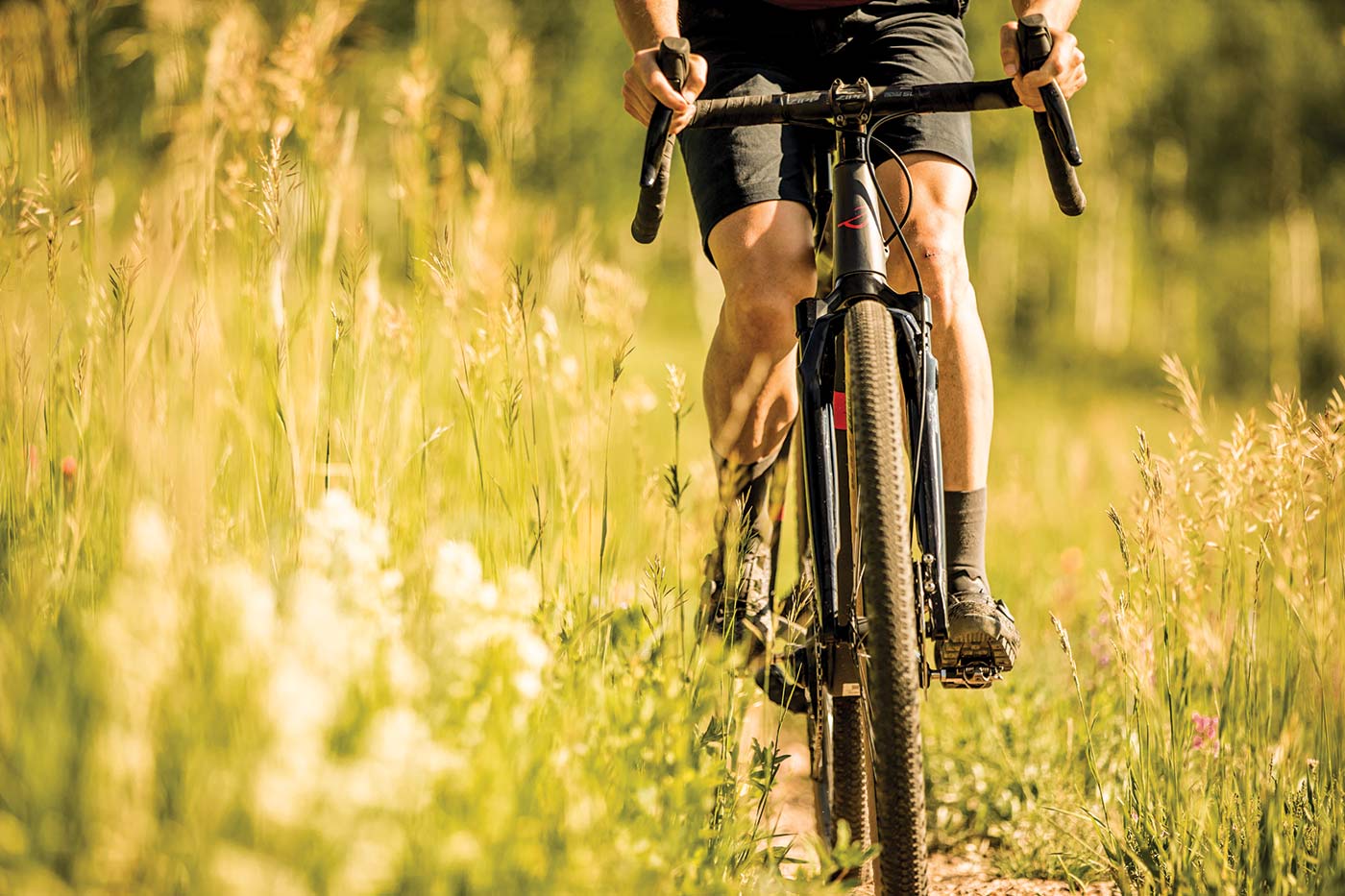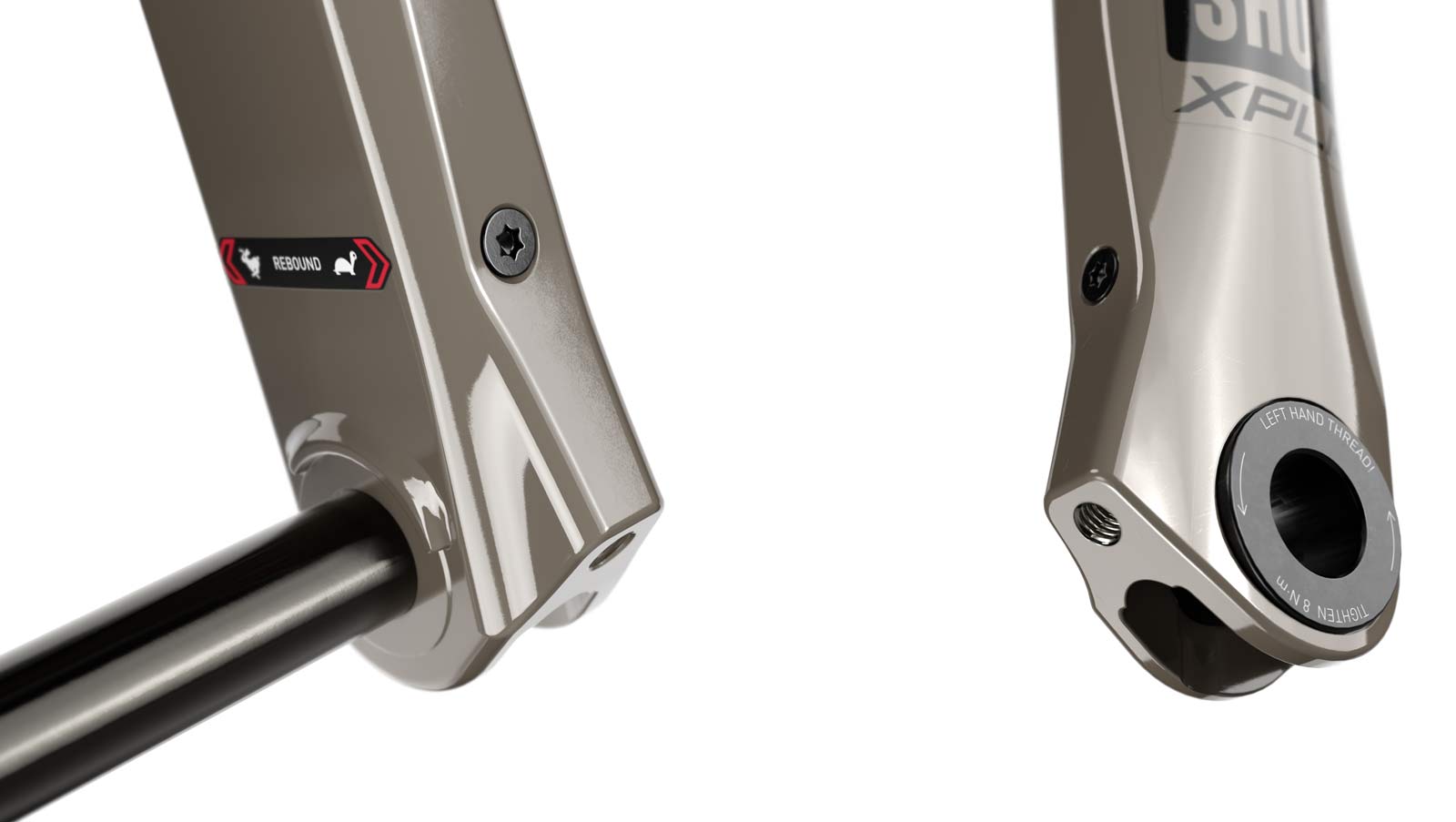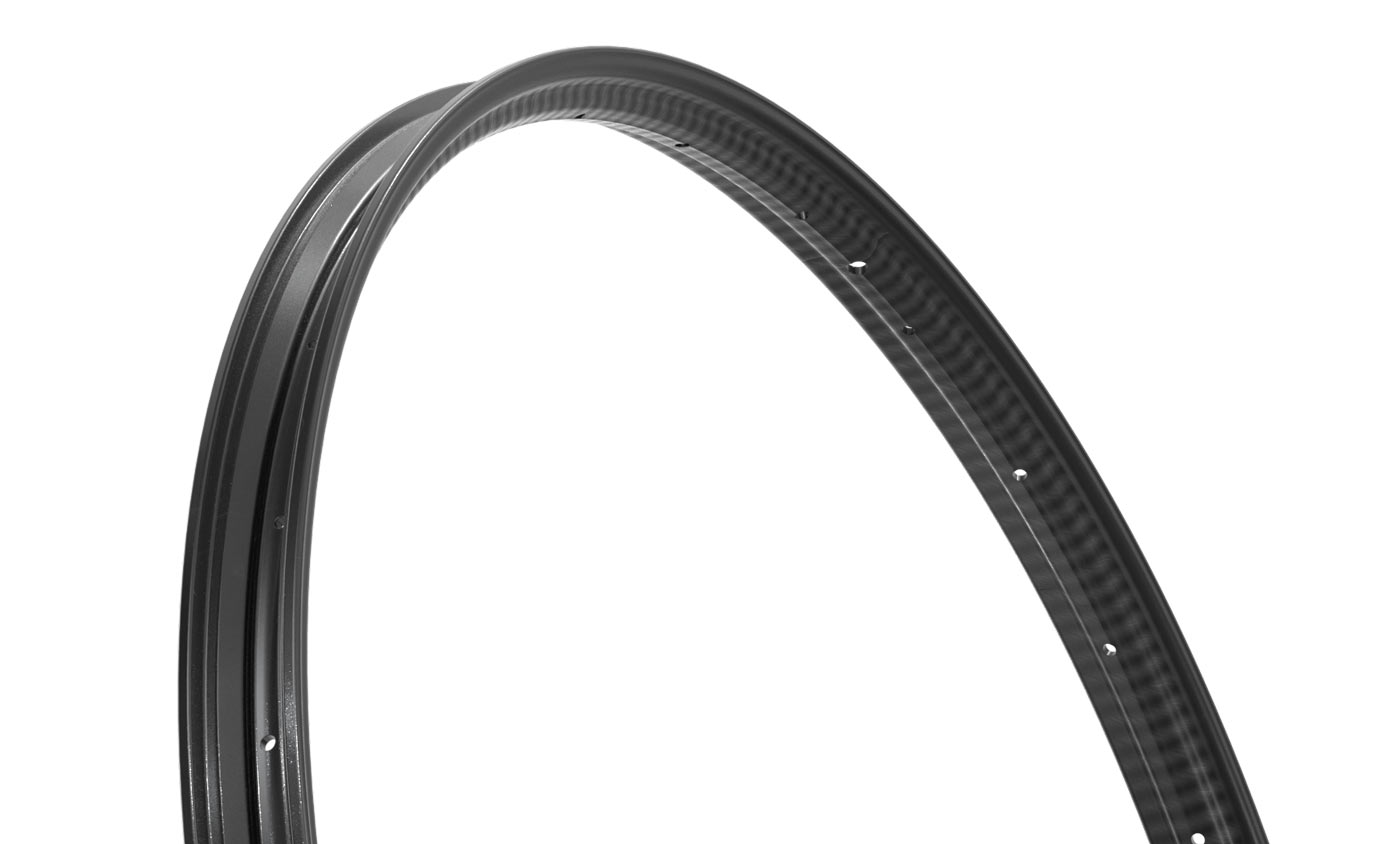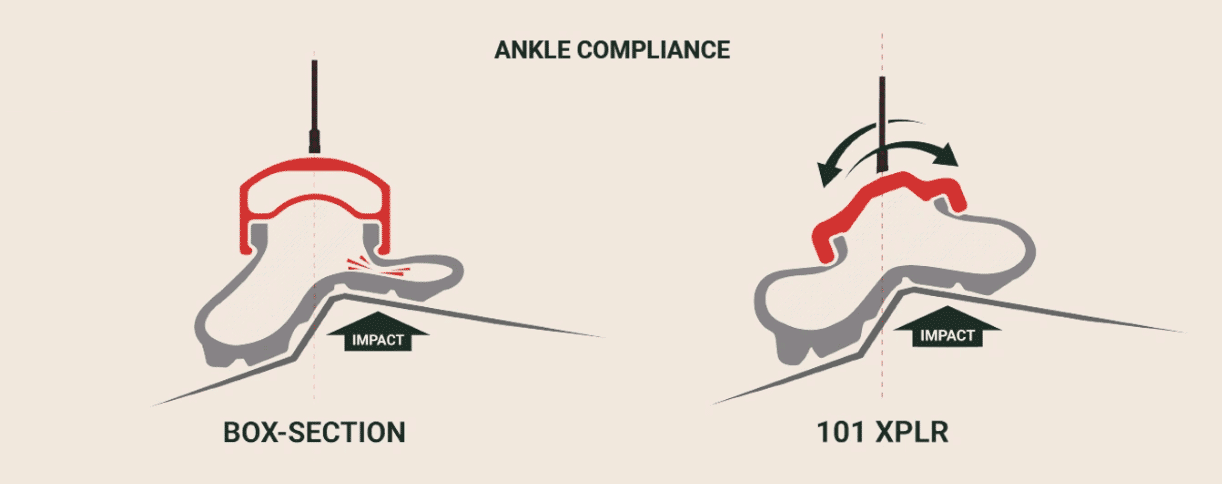The all-new SRAM XPLR gravel bike component line goes beyond the drivetrain, adding a Rockshox Rudy suspension fork, moto-inspired single-wall carbon rimmed Zipp wheels, and an impressive new air-sprung Reverb AXS dropper post that both drops and suspends the rider.
All of this moves forward with the help of wider 10-44 12-speed cassettes, new chainrings, and, of course, another new AXS derailleur option for Red, Force, and Rival…
TL;DR: What’s new with SRAM XPLR?
The XPLR (pronounced “explore”) group is a gravel-specific set of components, each optimized specifically for drop-bar gravel bikes. The components include:
- Two 10-44 12-speed cassettes, one Red/Force level and one Rival level
- Three AXS rear derailleurs (Red, Force, Rival) optimized for 10-36 to 10-44 cassettes
- Rockshox Rudy suspension fork with 30mm or 40mm of travel
- Reverb AXS dropper that locks out at top out, but provides suspension once dropped
- Zipp MOTO XPLR single-wall carbon wheels designed for the roughest roads
SRAM told us the goal for their new “ride however you want to ride” gravel group is to provide the sweet spot of gearing, so you always have the right gear whether you’re on gravel or tarmac. And with the suspension, to give the rider more control and comfort over any terrain.
Sound interesting? It is, and we explain it all below with an exclusive look at how the new Reverb air spring works. But first, let’s cover the new gearing…
SRAM XPLR cassette & derailleurs explained
Starting with the new drivetrain parts, SRAM has added two 10-44 cassettes specifically for their 12-speed road and gravel groups. It’s a slight bump up from the 10-42 options of their 11-speed mechanical groups, plus one more cog to improve gear steps.
For the AXS 12-speed groups, this new wide-range gravel cassette perfectly splits the difference between the 10-50 Eagle MTB cassettes popular on mullet builds, and the 10-36 cassette that debuted with the Force Wide group and later gained a compatible Red AXS derailleur.
Both one-piece XPLR cassettes have a 440% range and use their XDR freehub body. The only difference is the material on the 44-tooth cog. The higher-end Red/Force-level XG1271 uses an alloy cog, and the Rival-level XG1251 uses steel.

SRAM says these are NOT mountain bike cassettes, and they’re designed specifically for use with SRAM’s 12-speed Flattop road chain, not the Eagle MTB chains. Which means they are not designed to work with an Eagle AXS mountain bike derailleur, either.
Cassette Specs:
- 10-44 spread for 440% gear range
- XDR mount
- 10/11/13/15/17/19/21/24/288/32/38/44
- Claimed weights: 373g and 412g
- MSRP: $210 and $150
Joining the new 10-44 cassette is a new 1x-specific AXS rear derailleur. Yes, that’s another new derailleur design intended for a specific cassette range. SRAM has a lot of 12-speed AXS derailleurs now, with three versions for road and gravel bikes, plus their Eagle AXS MTB derailleur.
Fortunately, these new XPLR derailleurs will also work with the 10-36 cassette, too. And they come in Red, Force, and Rival varieties to match whatever else you have on your bike.
They pair with existing AXS controllers, including the mountain bike shifters if you wanted to build a flat bar gravel bike, so all you need to add is the new derailleur and cassette to get the wider gearing. And maybe a new chain as it might need to be longer.
OK, but WHY a new derailleur?
Because it’s optimized specifically for 1x drivetrains and wider ranges cassettes.
“We’ve wanted this gearing for a long time. One derailleur can only do so much,” explains Brad Menna, SRAM Road product manager. “There are performance constraints when you try to make one derailleur cover too broad of a range. If you stretch it too far, it becomes a performance compromise.”
These new derailleurs are 1x specific thanks to a new B-knuckle and pulley cage. The B-knuckle is longer, dropping the derailleur down and back slightly more than their 2x road derailleurs, which helps it clear the larger 44T cog without having to use a longer cage or a further offset upper pulley.

That shorter pulley cage, along with the offset of the cage itself, keeps shifting tight and should provide great chain management. But, the cage is not long enough to handle the extra chain required for an additional 13-tooth jump between front chainrings, hence the 1x-only designation.
Derailleur Specs:
- For use with 1x chainrings only
- Compatible with 10-36 and 10-44 cassettes
- RED: $710, 293g (317g w/ battery), Ceramic pulley bearings, Orbit damper
- Force: $350, 308g (332g w/ battery), Steel pulley bearings, Orbit damper
- Rival: $255, 327g (351g w/ battery), Steel pulley bearings, spring clutch
Note: Pricing is without the battery, so add $55 for that. Also interesting is that the Red XPLR derailleur uses an alloy cage, just like the Force and Rival, whereas their Red “road” AXS derailleurs have a carbon fiber cage. SRAM says this sped up development, and that a carbon cage would have had minimal weight savings over alloy for this mid-length design because they would have had to use more carbon to get the impact strength they wanted.
Seriously, I can’t keep their derailleurs straight…
Fortunately, SRAM provided this FAQ on exactly that:
Easy, right?
There are new, lighter one-piece chainrings, too
For Red and Force cranksets, they have new direct-mount 1x chainrings. They use the same current cranks that are on the market today, and use the same 8-bolt mounting pattern as the spiders on double chainrings, just with one-piece chainrings. It saves about 32-35 grams over a spider+chainring setup.

The recently updated Rival group actually came with 1x direct-mount chainrings from the start, but for RED and Force, these are new. They’re available in 38, 40, 42, 44, and 46 tooth options. These chainrings work on the Force Wide cranks, too, since the offset is built into the spindle on the “Wide” cranksets, not the chainrings.
Since the crank/chainring interface is the same across the line, it lets you easily add their Quarq powermeter spider later on to any of the cranksets…though the Rival cranks are available with a less expensive spindle-based power meter.
The direct mount chainrings are $99 (Red) and $60 (Force). Pricing and details for the complete cranksets with 1x chainrings shown in chart above.
Rockshox Rudy XPLR gravel suspension fork
The idea of suspension for gravel bikes is gaining steam, with more brands adding a short travel fork optimized for drop bar riding…but Rockshox had been noticeably absent, until now.
A while back, Rockshox’s product manager chopped down a SID, tried it on his gravel bike, and liked it. So he made a bunch of samples and sent them out to their pros to try out. The consistent feedback was that everyone liked the improved traction, control, and comfort. But they couldn’t just chop down a mountain bike fork and make it work…if for no other reason than aesthetics. But also, other reasons…like performance.
They say the goals were to give the rider more confidence with less body and hand fatigue, with more control on rough terrain. That, and maintain traction and steering precision by reducing the likelihood that the wheel gets bounced or deflected off obstacles.
The new Rudy XPLR (and yes, it’s RuDy, not RuBy) gets their Charger Race Day damper (introduced on the latest SID SL), because it’s the lightest damper they make…about 100g lighter than anything else.
It also had the features they wanted for a gravel fork, like a rock-solid lockout, a wide range of rebound adjust, and most importantly, lower overall compression damping. That means it works really well for the small chatter found on gravel roads.
For the spring, they used a new Solo Air spring that’s designed specifically for gravel and e-gravel bikes. The air volume is smaller, much closer to what’s in a rear shock, which made it a tricky fork to develop because there’s not as much volume to play with when designing the spring curve they wanted.
A short travel fork with a small air spring could have meant it was going to ramp hard, but they wanted it to be supple. Typically, a soft, supple fork is achieved with lower air pressure. But lower air pressure means it’s going to blow through its travel and end harshly.
They solved that by adding an elastomer “jounce” bottom out bumper that starts working at 50% of the stroke. It’s specifically shaped to come on softly initially, then progressively increase its support to better control the last half of the travel and cushion the bottom out.
So, soft fork, without a hard bottom out, that’s able to track the ground well and effectively use all of its travel.
Why not go inverted like the RS-1?
Compared to a SID, the RS-1 was a stiffer fork. But it was also heavier. And perhaps a little too stiff and too heavy for a gravel bike. Not to mention the freely spinning lowers made wheel insertion a little tricky if not downright frustrating…and required a special hub/axle interface.
Rockshox also said that they’re really good at making magnesium lowers and lightweight alloy uppers, so why not use that expertise? Lastly, making it this way is far more affordable, so the Rudy is a lot less than an inverted gravel fork with a carbon body would have been.
The compression adjustment has two settings up top – Open, and Locked Out. The rebound adjustment is handled by a small Torx bolt that sits flush on the lower right leg, and it has a far wider range of clicks.
All aftermarket forks come with a mini-fender that attaches to the crown. But, thanks to stealthy lower bosses hidden at the bottom of the dropout, you can attach full fenders if you want.
The lowers, crown, and everything else are machined as much as possible to save weight. The claimed 1227g weight is with the steerer tube cut to 230mm steerer, the same length as their mountain bike forks. But the forks come with 320mm steerers in case your gravel bike has a much taller headtube.
Rudy XPLR Ultimate tech specs
Here are the quick specs:
- 30mm and 40mm travel options
- 700×50 max tire size
- 30mm stanchions are lighter and look better on a drop bar bike
- 12×100 thru axle, includes Maxle Stealth
- 1,227g claimed weight w/ 230mm cut steerer
- 160mm direct flat mount brakes, will work with up to 180mm rotors
- 45mm offset only for aftermarket, 51mm available for OEM
- MSRP: $799 (€869 / £799 including VAT)
They say we’ll see it as OEM placement on a number of bikes, some of which are designed from the outset with suspension corrected geometry…but not all of them. The Ruby XPLR has a 425mm a-to-c with 30mm travel.
For starters, it’ll only be available in the 12×100 axle standard, but if demand grows for the Road Boost standard, they’ll offer that, too.
On a typical bike, it’ll add about 20-25mm of axle-to-crown height on many current gravel bikes. So, it will slow down your steering a bit, but it’s kinda like throwing a 120mm fork on your 100mm XC bike…it’s not that noticeable.
Reverb AXS XPLR suspension dropper seatpost
The Reverb AXS XPLR dropper post is all new…not just a chopped down version of the mountain bike post. It’s built specifically for gravel in the most wonderful way possible…it adds suspension travel as soon as you drop it.
Meaning, when fully extended, it’s locked out (think, Topped Out, Locked Out), but drop it even 1mm and it uses an air spring as a suspension seatpost. They call it ActiveRide, and the amount of suspension you get out of it, and the firmness, depends on how much air pressure you put in it. To do this, it’s a full air system, there are no hydraulics in it like the mountain bike Reverbs.
How does the dropper-turned-air spring work?
“We didn’t want to just make a post that went up or down, we felt like there was a different use case for gravel,” says SRAM MTB PR rep Chris Mandell. “We wanted to make something that could help a rider keep their butt on the saddle and really lay down the power on rough roads.”
Here’s how it works:
When it’s topped out, there’s effectively no negative air spring, so it’s a very rigid system. But when you open the valve to drop the post, it opens up access to a negative spring, and thus allows proper “suspension” movement.
So, effectively, it’s like an extremely strong positive air spring to hold you up during lock out, but once you drop into the travel, it’s like sitting on a typical air spring with a negative spring to ease you into the motion…like your fork, or rear shock.
Except that it’s also still able to maintain the lowered position while using that travel…and that’s their secret sauce. Rockshox is being coy on the exact inner workings while they wait for the patents to go through, but they did say there’s no physical, mechanical lockout…it really is only the air pressure that’s holding the saddle up at lockout.
Inside the air spring, there’s no bypass dimple to pressurize the negative spring either. Instead, there’s a dynamic seal to equalize the chambers once you drop into its travel. And you only need to drop 1mm into the travel to open things up and have it act as a suspension seatpost.
SRAM recommends setting the air pressure (via the Schrader valve on the bottom of the post) to 2x your rider+kit weight, but you can deviate from that to tune it to your liking. So, just be aware that if you set it up really soft and, say, drop the post halfway into the travel, if you hit something big while seated, you could bottom it out. But that’s mostly OK…
There is a bottom-out bumper in there, but the real reason not to be too concerned with this is that it’s also unlikely you’re going to be seated and hammering while the post is significantly dropped…because we really only drop the post when we’re getting off the saddle to descend some gnarly terrain.
Reverb AXS XPLR tech specs
- 27.2mm diameter only
- 50mm and 75mm travel options
- 350mm and 400mm lengths (50mm travel only gets 350mm length)
- Includes battery & charger
- AXS controller sold separately (see below)
- Oval/Round (7×9, 7mm round) clamp standard, Oval (7×10) clamp sold separately
- Compatible with most oversized seat bags
- Claimed weight: 567g for 75×400 size (591g w/ battery)
- MSRP: $600 (€600 / £500 including VAT)
Reverb AXS XPLR controller options
The Reverb AXS can be controlled with any of the existing AXS shifters, blips, or triggers. Options include:
- Flat Bar: RockShox AXS Controller; Blip Box with Multi Clics or Blips
- SRAM RED and Force 1x: Multi Clics or Blips in lever ports; 2x tap on Shifter levers
- SRAM RED and Force 2x: Multi Clics or Blips in lever ports
- Rival 1x: Blip Box with Multi Clics or Blips; 2x tap on shifter levers
- Rival 2x: Blip Box with Multi Clics or Blips
For 1x systems, the “2x tap” control means a simultaneous push of left and right shift paddles…similar to how you’d perform a front shift on a 2x drivetrain. We’re thinking one of the Multi Clics/Blips might be a more intuitive method, but the nice thing is you have options. Just set up whatever you want inside the AXS app.
Zipp 101 XPLR gravel bike wheels
These are Zipp’s first gravel-specific wheels, and one of few gravel wheels that aren’t directly based on road bike wheels. We’ve seen a lot of brands launch “gravel wheels”, but they mostly all look like road wheels, perhaps with a few tweaks to the design to make them offroad capable.
Zipp took a different approach. Yeah, their latest 303 series are great offroad, but they thought they could do better. With those latest 303 (and the more recently revamped 404) wheels, they went after more than aerodynamics. The system approach also targeted vibration and traction as a way of improving rider comfort and efficiency.
With these new Zipp 101 XPLR wheels, they take that a step further, using the single-wall design from their 3 Zero MOTO mountain bike wheels to maximize all the ways they could improve rider comfort, reduce fatigue, and maximize total system performance. And then they reduced the likelihood of pinch flats, and enhanced traction.
Here’s how it all works:
Zipp’s MOTO single-wall rims allow for better and more total compliance, and more types of compliance. The big one is “Ankle Compliance”, which allows the rim to tilt around the spoke’s nipple.
Think of it like your foot being able to flex at your ankle in the transverse plane, so your foot can adjust to the ground. It’s only a few millimeters of flex per side, but it takes the edge off angular impacts and provides better traction.
The rims have a hookless, tubeless design with a 27mm internal width, which sounds huge, but their road wheels are 23-25mm wide. These are optimized for 38-45mm wide tires, but you could go as small as 35mm or, at least according to ETRTO guidelines, as big as 2.6″ (65mm).
But realistically, it’s designed for the big gravel tires most of us are riding these days, up to about 50-55mm. Which is another way of saying you’re only really limited on tire size by your frame clearance.
Zipp 101 XPLR specs
- 27mm internal width
- Hookless tubeless bead
- Centerlock brake rotor mounts
- Claimed weights: 700c (1665g) and 650B (1590g)
- TireWiz available separately w/ custom flush-fit grommet
- ZR1 hubset with 66 points of engagement, same as Firecrest-level road wheels
- 28 Sapim CX Sprint spokes per wheel
- Comes with Kwiqsand or Carbon (shown) graphics
- Lifetime Warranty
- MSRP – FRONT: $850 (€870 / £780 including VAT)
- MSRP – REAR: $950 (€970 / £866 including VAT)
About those weights, they’re not light by today’s standards for high-end, high-performance gravel bike racing wheels. But, SRAM says they’re about the same weight as the prior generation 303 Firecrest wheels. And these rims are about 100g lighter than the mountain bike MOTO rims.
We say, it’s “horses for courses”. If you’re riding really rough courses, these rims’ comfort and traction gains could outweigh the weight penalty. Think Grinduro, not Belgian Waffle Ride.
Zipp’s G40 gravel tires get rebranded as XPLR, but carry over otherwise unchanged…still only available in a 700×40, tan wall, 480g gravel tire. And the alloy Zipp Service Course SL-70 XPLR handlebar rounds out the family with a flared cockpit part designed for better hand positions on aggressive terrain.
When are the XPLR parts available?
SRAM Red and Force drivetrain parts will become available in August, with wider availability in September. Rival parts follow one month behind. Cassettes could be delayed up to one month behind the rest, particularly for complete bikes spec’ing them.
The Rudy XPLR Ultimate fork and Zipp 101 XPLR wheels start shipping in August, with wider availability in September (fork) and later (wheels). The Reverb AXS XPLR ships in September with more coming later in the year.
Basically, the first batch is limited, so get your order in quickly if you want them…or wait until later in the year. But, you can check their Bike Finder now to see who’s already spec’ing it.
Stay tuned for our first ride impressions and video overview, coming soon…


